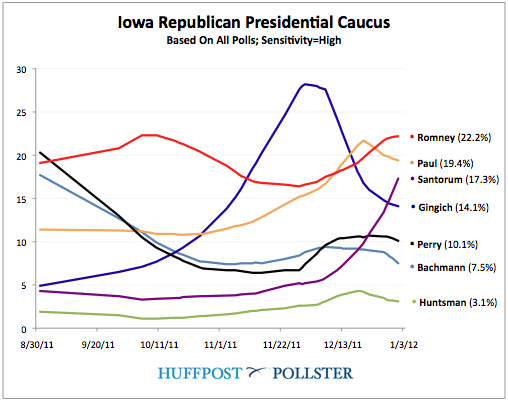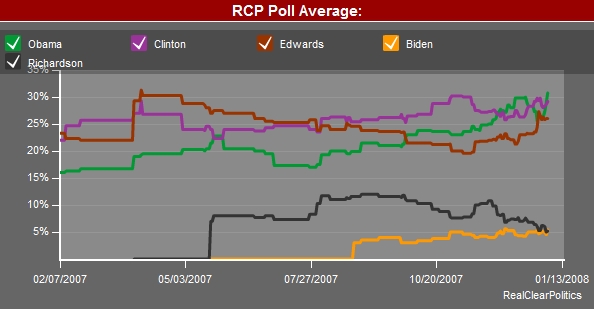After subjecting you to a barrage of polling analysis these past few days, I would be remiss if I didn’t offer a prediction for tonight’s Iowa caucus. And so I will. But let me preface it by saying, intellectually, predicting the results of the Iowa caucus isn’t a very satisfying exercise. And that’ s because we (and by we I mean political scientists) do not, as far as I know, have an incredibly insightful theory or model that explains how Iowa works. There’s just too many moving parts. Turnout is hard to predict. There’s more than two candidates. Information levels are low. This stands in contrast to our work on the presidential election. There, I’m pretty confident that we know enough of the story to hazard a prediction several months before election day. Not so in Iowa.
So, what’s the best way to predict the outcome, given a lack of an underlying model? Simple. Just aggregate recent polls and use that to produce a rank order finish. One can get fancy and try to weight polls on past accuracy, their sampling choices, etc., but that’s probably methodological overkill. In the end, a simple aggregation of recent polls has proved reliable in the past.
For example, if we look back at 2004, most of the final polls had the order right, if not the vote totals. Of course,because of the 15% threshold, it’s hard to pin down the actual vote totals.Still they got the rank order largely correct although there was some discrepancy in the second place finish.

Similarly, they got the order largely right in 2000 for the Republican race:

And the Democratic one too:

Same story for 2008, with the exception of the close finish between Clinton and Edwards for second place.
So rather than present some complex model based on dubious assumptions, let me show the final rank ordering, with vote totals, in two composite polling aggregators. The first is from Pollster.com:

The second is from RealClear Politics (Romney is purple, Paul is yellow and Santorum is brown).
 Fortunately, both have identical rank orderings. Here’s a summary table of the results from the two composite polls.
Fortunately, both have identical rank orderings. Here’s a summary table of the results from the two composite polls.
| Candidate | Real Clear Politics | Pollster.Com | Average of the Two |
| Romney | 23.9 | 23.7 | 23.8 |
| Paul | 22.5 | 20.1 | 21.3 |
| Santorum | 17.1 | 18.0 | 17.6 |
| Gingrich | 14.3 | 13.6 | 14.0 |
| Perry | 10.4 | 12.1 | 11.2 |
| Bachmann | 7.9 | 8.7 | 8.3 |
So, let the third column be my prediction! Simple and tidy. Of course, I’m more confident of the rank ordering than of the vote totals, but it’s close enough for political science.
Now, what factors might upset this tidy picture? Obviously turnout matters, but I’ve gone through that before. Note, however, that some pundits are arguing that higher turnout favors Romney, while others says it benefits Paul. I’ve have no idea how aggregate turnout levels will impact the outcome, so I’ll ignore the issue for now.
The second confounding factor might be trends that the average of the polls are missing. The biggest unknown is whether Santorum has peaked (which is what some are saying) or not. Again, I have no idea. It does seem to me, however, that Paul’s support is slipping. So if this order is to change, it may be that Santorum squeaks ahead of Paul and – possibly – Romney. But in the absence of evidence pertaining to his support, I’m going to ignore this as well.
So there you have it. Romney to win, Paul to place, Santorum to show, with Gingrich hanging on to fourth. Of course, actual vote totals are important because they will affect how the media plays the expectations game. I’ll be back on in an hour or so for some live blogging of the blessed event, at which point I’ll run through some caucus procedures and try to put the results in perspective.
Hope to see you then.

